Person Record
Metadata
Name |
Kimball, Stephen Farrington (1852-1934) |
Other Names |
Uncle Steve |
Born |
April 1, 1852 |
Birthplace |
Lovell, ME |
Places of Residence |
Lovell, ME |
Father |
Enos H. Kimball |
Mother |
Catherine (McDaniels) Kimball |
Notes |
Intentions of Marriage entered Oct 19, 1877 Married Nov 18, 1877 by Rev. Elias S. Foster Taken from the Fall 2012 Newsletter, written by Catherine Stone: Stephen Farrington Kimball (1852-1934), also known as "Uncle Steve", was a Lovell native who gained notoriety for his dance fiddling and calling. His music was recorded by the Victor Band, he spent time at Columbia University teaching the old dances, and he had a brief career as a nightclub sensation in New York City. Despite these accomplishments, he spent most of his life working various jobs in the area and died in relative obscurity. So little attention was given to him locally, that it appeared there were two Stephen Kimball’s living in Lovell at the same time. Steve was born in Lovell on April 1, 1852, the son of Enos and Catherine (McDaniels) Kimball. According to The History of the Kimball Family by Leonard A. Morrison & Stephen P. Sharples, his occupation was "paper hanger and painter". Sumner Kimball, who was the nephew of Enos, repeatedly mentioned hiring Enos and Steve to paint his home, now known as the Kimball-Stanford House. Steve married Hattie Maria Marston (1856-1916) of Waterford on November 18, 1877 and they had one child, Sadie E. Kimball, born December 22, 1879. In reviewing old Lovell Town Columns from the Lovell Historical Society’s collection, the first reference made to Steve’s career as a fiddler and caller was in August 5, 1887 when the following was noted: "Stephen Kimball entertained the No. 4 Circle at the skating rink [today’s VFW Hall] Tuesday, July 28. Time or labor was not spared by Mr. K. in preparing for the occasion so that one and all might find much enjoyment during the afternoon and evening." Over the next forty-seven years Steve was sporadically mentioned in town columns, but not for his musical talents. Instead, reference was made over the years to his fishing and hunting. In 1892 a column mentioned his taking work at the Norway shoe shop, and in 1897 he was referred to as S.F. Kimball of Norway. By 1909 the family appears to have returned to Lovell, as mention was made of Steve taking on odd jobs such as well digging and ice cutting. Hattie was mentioned for her work tending the ill and taking in boarders at their home in Northeast Lovell. By the time Hattie died of tuberculosis in 1916, Steve’s notoriety was minimal. It was not until after her death that he somehow became acquainted with Elizabeth Burchenal, a Columbia University folk dance scholar. The era of square dancing as a mainstay of local balls was being replaced by new styles of music and dance, and Burchenal was determined to document the old style. She published a book, American Country-Dances, in 1918 and credited Steve as her primary source. Her 1922 Folk-Dances from Old Homelands included "Uncle Steve’s Quadrille", which was later recorded by the Victor Band with calls by Billy Murray. It’s not known how he became acquainted with Burchenal, but it is likely she was instrumental in arranging his trip to New York City during the winter of 1924. According to an article in the Lewiston Evening Journal, dated January 6, 1926, Steve received in the mail a job offer to play the role of Santa Claus for a large department store. Accompanying the offer was a railway ticket from Norway to New York City. What follows is Steve’s account of what transpired that winter: Miss Burchenal told me that as soon as I got thru playing Santa Claus to let her know. I did so. She was one of a merry party of New York young people who desired to dance the old-time dances. Among her friends were eight couples, sixteen people, thus making up two sets in quadrille. They met in her house first, then at the home of each of the couples and then repeated it— I fiddled and taught them how to dance the square dances sixteen evenings. Then Miss Burchenal planned a surprise. I knew nothing of it in advance. She told me to be dressed in my best and be ready for a taxi to take me at a certain place—known to the driver. I did as she bade me. We went to a large private club house in the former Samuel J. Tilden house. I peeked thru the doors and saw a large party sitting at dinner, some 200 people I should say. With Miss Burchenal’s party—eight couples who had been dancing—I went onto the stage and Miss Burhenal told me the doors would be opened and we would go thru our dance just as we had been doing all winter. The doors were opened. I fiddled a few snatches of a merry jig tune then called for the forming of a fancy quadrille. The couples took their places. I fiddled and called out the various floor movements and we went thru the dance as usual. Such cheering as we got and we had to repeat it several times. When we were back in the taxi and I was on my way to the rooms, Miss Burchenal told me with a merry twinkle that we had been dancing at the National Art Club of New York City. At another time a gentleman – can’t remember his name now, but I have it in my diary at home – asked me to meet him at the Lincoln Hotel on Broadway. "You can fiddle?" he asked. "A little," I answered, and at his request played a few jigs and reels for him. He appeared satisfied and said "A taxi will call for you at eight this evening and I want you dressed in rustic clothes and meet me at ----- Club House. He named a fashionable club house in the city. The name of it is along with his name in my diary. "I will play the piano and you will fiddle," he said. "I will ask you some questions and you can answer them in a witty way." I had a rusty old overcoat which I had worn for warmth on the stage journey from Lovell to Norway where I took the train for New York and I wore this to my friend’s party. I didn’t need much make-up with my white hair and long white beard. He went ahead onto the stage and sat down and instructed me to rap on the door and follow shortly. I did his bidding and the following dialogue ensued: "Come in." I entered slowly, fiddle box in hand and there was a general hand clapping. "Wall, now I swan, if here ain’t my old friend Uncle Stephen Kimball from Lovell, Maine. How be you, Uncle Stephen!" "Purty fair and middlin’," I answered. "Wall, I ain’t seen you since the British vaccinated New York." There was a general laugh at this sally. He went on in this strain, asked how so and so was down to Lovell, Maine – using names I presume of fashionable persons in the audience, for they laughed and shouted as he made each sally. He would ask how Nancy Smith or some such person was and I would answer, "She is helping her father in the hay field or is trying to learn how to make biscuit or darn sock" or some other such nonsense. Evidently my random remarks and answers must have hit home on more than one occasion and perhaps made as much fun as if I had been coached in advance. He asked how one girl was ‘away down there to Lovell and I told him in answer that I’d thank him for not being too free with her name; that I had sparked her myself and been to corn huskings and was darn sweet on her myself. There was a great laugh, a lot of cheering and then he said in an undertone, "You hit it that time, she is my wife! I was trying to spring a joke on her and you caught me at the same time!" "But honestly," I said soberly "I didn’t mean no – harm." Three years later, Steve approached summer resident Don Dickerman with a proposal to perform at one of his nightclubs in New York City. At the time, Dickerman owned three clubs, one being the "County Fair". The club was promoted as being designed after the Oxford County Fair at Fryeburg: "The dance floor is a race track with a specially fenced off outer track for the fast steppers. The famous Eddie Worth orchestra in country band costumes occupy the grandstand while the midway and exhibit row are where the people sit with the funny signs up overhead. White fences are everywhere and hundreds of little silk flags waving in artificial breezes under a blue satin sky". An act was created with Steve fiddling and calling for five Lovell couples. To advertise the event, Dickerman created a hand-drawn cartoon which took up two-thirds of a page in The New Yorker with this message: "I have signed up the grandest bunch of real ‘Down-East’ natives all old friends of mine who will do a little medley of the American country dances for us three times nightly as they have been done for the last hundred years up here in the good old back woods. Wait till you hear old Uncle Steve Kimball fiddle and then see him peel down to his suspenders and do the Portland Fancy!" The following week he ran another two-thirds page, headed "Special Anniversary Notice". Their first performance was on October 31 and ran until December 10, three fifteen minute shows a night, at 6, 9, and 12. The act was an instant success, as evidenced by Lois Long’s review in The New Yorker: Downtown, Don Dickerman has brought twelve Down East natives to dance the Portland Fancy, the Lady of the Lake, and other old-fashioned dances at dinner, at 10:30, and at supper, at the County Fair. And after considerable toil and trouble in inducing them to leave the caouws for a spell, he is now accused of employing actors dressed up. Well, they are not. I know my Maine. No actor could possible refrain from saying "By Heck" or spitting ‘backy juice on the floor, which the real ones would scorn to do. They are sweet and utterly un-self-conscious. And I have mailed a proposal of marriage to Uncle Steve Kimball, who is seventy-six, boasts the longest and waviest white beard I ever did see, and fiddles in a class with his cousin, Mellie Dunham. My word for the whole thing— and you know what a word-coiner I am—is "refreshing". On December 16, 1927, the Norway Advertiser published an article about the act’s success, largely quoting from a letter by Don Dickerman which is excerpted below: In justice to a group of citizens from your neighboring town of Lovell, who are making an enormous hit here in sophisticated New York City, I am writing to give you a few notes on their success. The rendering of the old fashioned country dances to the tune of Uncle Steve Kimball’s fiddling is the most charming, sincere performance which has ever been offered in New York City. They are all very dear friends of mine from the region of my summer camp on Kezar Lake and I am very sure that you will be mighty proud to know that their little act, together with their great personal charm, is absolutely winning the heart of New York City. My "County Fair" is an aristocratic dinner and supper club patronized largely by smart New Yorkers and are a hard crowd to please, but these people have won the most enthusiastic applause that I have ever heard at any exhibition dance, including the greatest stars of New York City. We will indeed by very sorry when the six weeks contract is up on December 10th and while we have done all we can to keep them happy in New York, they are getting a little homesick for their beautiful Kezar Lake Valley and decidedly hungry for the good old fashioned beans. I am writing to you as their home paper, because I feel that they have earned the cheers of the folks back home and want to spread the news of their success in their home state. During their six weeks in New York, about 25,000 people will have enjoyed their dancing. They have [im]mortalized the grand old American classics which are fast giving way to the innovations of modern jazz. It does not appear that Steve ever visited New York City again. When he passed away on March 5, 1934 at the age of eighty-one he was boarding at Dana McAllister’s home in West Lovell. Only brief mention in the Norway Advertiser was made of his passing. It was noted that his internment was to be at No. 4 Cemetery in Lovell, which was where Hattie was buried. Presumably they were buried next to each other, but no headstone marks their location. His death notice did not mention his career as a famed fiddler and caller. Fortunately, his talents did not live in obscurity thanks to the work of a Columbia University folk dance scholar and Don Dickerman. |
Occupation |
Painter and wallpaper hanger, working with his father. Fiddler and Caller. |
Spouse |
Hattie Maria (Marston) Kimball |
Children |
Sadie E. |
Deceased |
Mar 5, 1934 |
Deceased Where |
Lovell, ME |
Related Records
-

-
Deaths 1892-1939 - 1974.02.1342
Index and photocopy of Lovell's deaths from 1892 through 1939. Located in a notebook titled Births Deaths 1892-1939 Vital Statistics 1910-1945." A photocopy of the book can be found in the archival box "Lovell Vital Records Box 3."
Record Type: Archive

-
Family Records, 1765-1901, Town of Lovell - 1974.02.0689
A transcription of the Lovell Clerk's vital records book titled "Family Records, 1765-1901, Town of Lovell", giving births and deaths. The records were transcribed by Marcia Storkerson and Indexed by Catherine Stone for the Lovell Historical Society November, 2008. Copies can be found at the Historical Society and the Town Office. The transcription can also be viewed on the Lovell Historical Society's website, lovellhistoricalsociety.org, by cl...
Record Type: Archive

-
Kimball, "Uncle" Steve - 1974.02.1039
Information on "Uncle" Steve Kimball. Located in the file category "People".
Record Type: Archive

-
Lovell Square Dancers - 2020.20.0001
Group photo of the Lovell Square Dancers. The people identified in the photo are: Front row, left to right, Anne Hodsdon, Helen Farrington, Uncle Steve Kimball, Minnie Sawyer and Marie Palmer. Back row, left to right, John Farrington, Ed "The Deacon" Hodsdon, Irma Hodsdon, Reggie Pitman, Prod Poor, Maude Silkworth, Gerald Palmer and Linwood Sawyer . According to Minnie Sawyer's scrapbook from the period, they went to New York with Don Dicke...
Record Type: Photo
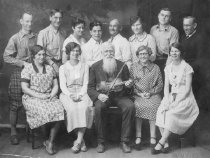
-
Marriage Intentions & Marriages, 1831-1886 - 2022.01.0010
Indexed transcription of the Lovell Clerk's vital records book titled "Marriage Intentions and Marriages, 1831-1886, Town of Lovell." These records were transcribed by Marcia Storkerson and indexed by Connie Miles for the Lovell Historical Society. The transcription and index can be found in an archival notebook labelled "Marriage Intentions & Marriages, Town of Lovell, 1802-1939." A photocopy of the book is located in the archival box "Lovell Vi...
Record Type: Archive

-
Minnie Sawyer's Squaredancing Scrapbook - 1991.01.0011
Minnie Sawyer's scrapbook when she performed with Uncle Steve Kimball as a square dancer at Don Dickerman's "County Fair" nightclub. The dancers stayed at the Hotel Albert in New York City. The Hotel published "Knott Knotes" a magazine for the stockholders in the Knott Corporation, which financed the Hotel. Minnie used the magazine as a platform for her scrapbook.
Record Type: Archive

-
Stephen Kimball Playing His Violin - 1998.01.0009
Stephen Kimball playing his violin. Used in the Fall 2012 Newsletter.
Record Type: Photo
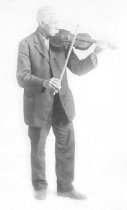
-
Steve Kimball Advertisement - 1986.01.0010
Uncle Steve Kimball and his violin advertisement saying "Real Down East Natives from Maine at the County Fair, 54 East 9th. Maine Memory Net: "Uncle Steve Kimball was a fiddler. 'A group of square dancers from Lovell were invited to go to New York and perform at Don Dickerman's nightclub, The Country Fair. Uncle Steve Kimball was the fiddler. The New Yorkers could not believe that this was not a group of actors dressed for the occasion. The...
Record Type: Photo
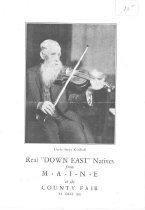
-
The Lovell Square Dancers - 1974.02.0661
Photo with accompanying letter by Don Dickerman which appeared in Down East Magazine, June 1970, about the Lovell Square Dancers. The people identified in the photo are: Front row, left to right, Anne Hodsdon, Helen Farrington, Uncle Steve Kimball, Minnie Sawyer and Marie Palmer. Back row, left to right, John Farrington, Ed "The Deacon" Hodsdon, Irma Hodsdon, Reggie Pitman, Prod Poor, Maude Silkworth, Gerald Palmer and Linwood Sawyer . Acco...
Record Type: Photo
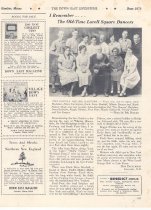
-
Uncle Steve Kimball - 2012.01.0018
Stephen Kimball photograph found in Elizabeth Burchenal's "American Country Dances". Taken from Photo CD #7.
Record Type: Photo
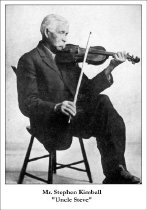
-
Uncle Steve Kimball Posing with Fiddle - 2005.16.0015
Portrait of Uncle Steve Kimball holding his fiddle. Also on the Joni Fox-Campbell Photo CD. Used in the Fall 2012 Newsletter.
Record Type: Photo
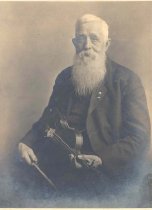
-
Uncle Steve Kimball's Quadrille & Haymaker's Jig - 2011.19.0001
A recording of Uncle Steve Kimball's Quadrille and Haymaker's Jig by the Victor Band in 1923. Calls are made by Billy Murray. 2 copies. Included in the Stephen Kimball "People" file are instructions by Elizabeth Burchenal on the dance.
Record Type: Archive

-
Uncle Steve Kimball's Sicilian Circle - 2011.85.0001
A recording of Uncle Steve Kimball's Sicilian Circle by the Victor Band in 1927. Calls are made by Billy Murray. Included in the Stephen Kimball "People" file is the sheet music. The CD includes two other Circles and two Quadrilles.
Record Type: Archive


